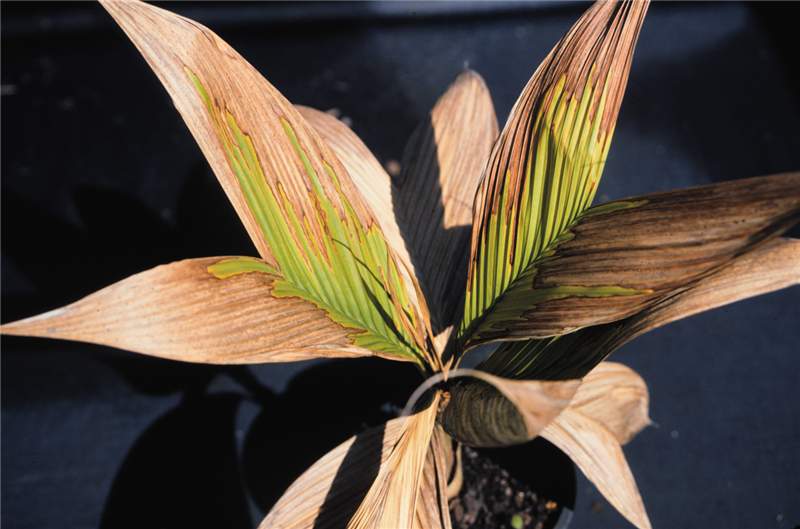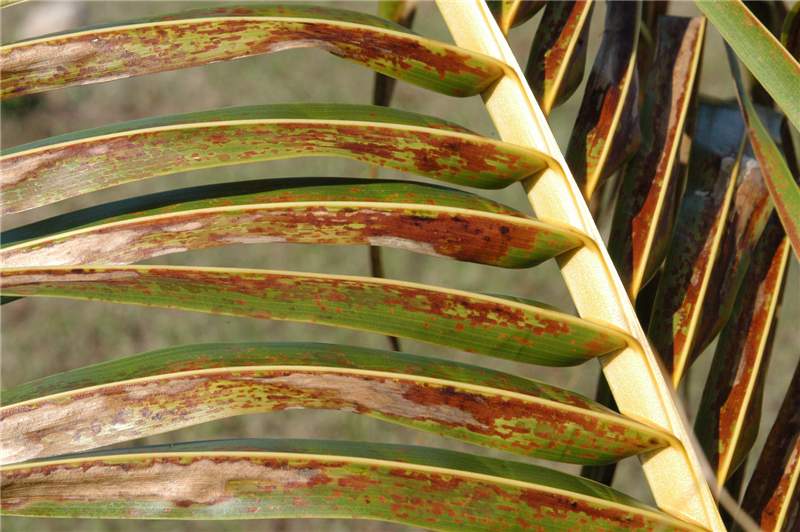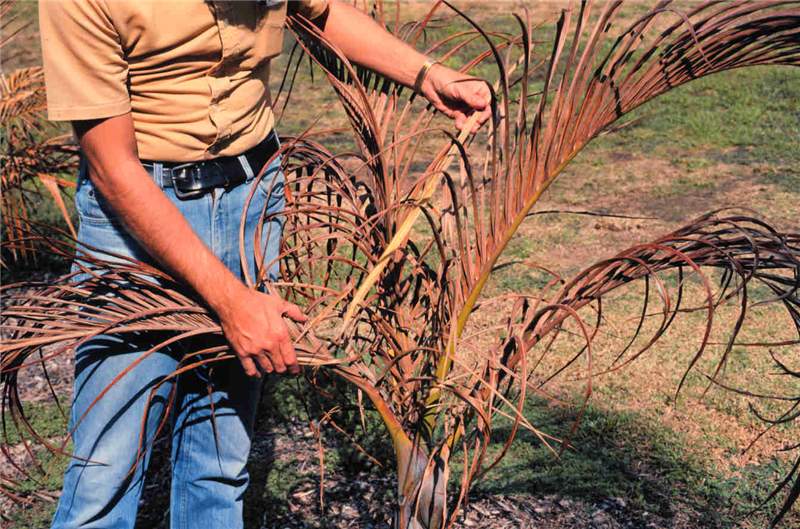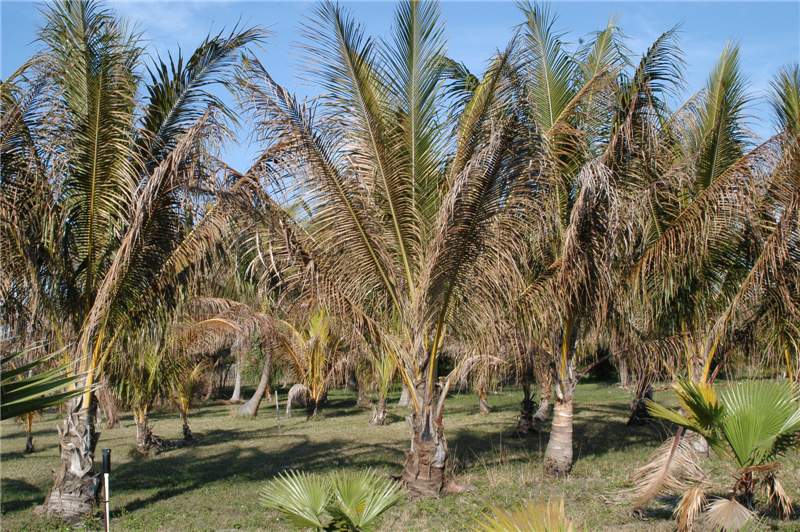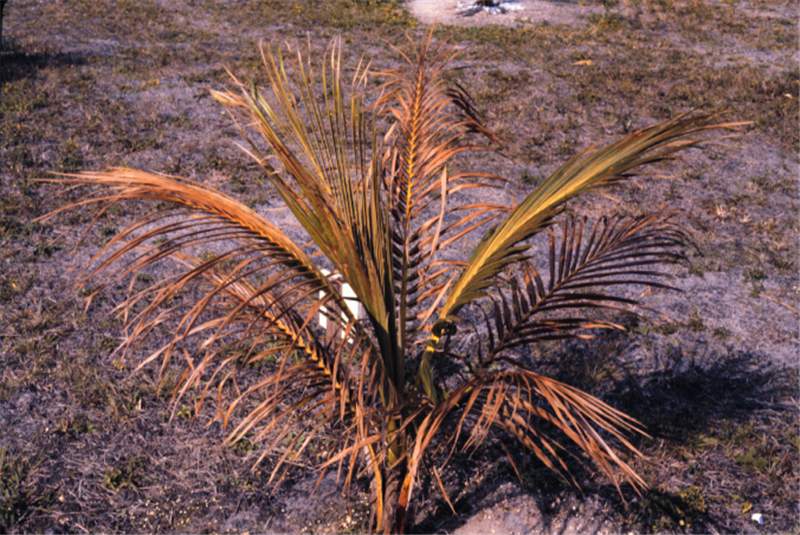Cold Damage
|
Figure 2. Chilling injury on Geonoma sp. showing foliar necrosis. Photo by T.K. Broschat.
|
|
Figure 1. Mild chilling injury symptoms on leaf of Cocos nucifera showing reddish blotches on the top of the leaflets. Photo by T.K. Broschat.
|
|
Figure 4. Basal spear leaf rot on Hyophorbe verschafeltii caused by secondary bacteria and fungi following freeze damage to the base of the spear leaf. Photo by T.K. Broschat.
|
|
Figure 3. Chilling injury on Cocos nucifera showing the distribution of necrosis within and among leaves. Photo by T.K. Broschat.
|
|
Figure 5. Wilting of living leaf tissue of Cocos nucifera following a freeze. Photo by T.K. Broschat.
|
Symptoms
Symptoms of cold damage vary with the intensity and duration of the cold event. Chilling injury can occur on tropical species at temperatures above freezing, with symptoms of discoloration, reddish or black spotting or blotches, or necrosisnecrosis:
dead tissue, usually desiccated and brown to gray in color
of the leaflets (Figs. 1 and 2). The youngest, partially expanded leaf is typically less affected than older foliage, and the petioles and rachisrachis:
the axis of a leaf beyond the petiole or an extension of the petiole into the leaf blade
will usually be the last tissues to become necroticnecrotic:
see necrosis
(Fig. 3). Premature fruit drop is also an early symptom of chilling injury. As the temperature experienced decreases to freezing or below, the primary symptom is foliar necrosisnecrosis:
dead tissue, usually desiccated and brown to gray in color
, with the same within-plant distributional pattern followed as with chilling injury. Severe freezes cause necrosisnecrosis:
dead tissue, usually desiccated and brown to gray in color
of the spear leaf baseleaf base:
the basal portion of a leaf petiole that is attached to the stem
and secondary saprophytic bacteria and fungi colonizing this dead tissue can cause a basalbasal:
closest to the point of attachment
spear leaf rot (Fig. 4). In this situation, the spear leafspear leaf:
the younges emerging leaf that has not yet opened
can easily be pulled out, and the mushy base will emit a foul odor. If these secondary microbes reach the meristematic tissue, the primary meristemmeristem:
the growing region of a plant, a special area of undifferentiated cells wherein new cells and organs are developed
itself can be killed, resulting in the death of the palm.
Prolonged cold, but not necessarily freezing, temperatures can cause a wilt and eventually death of any green tissue remaining after the coldest weather, particularly in very tropical species such as Cocos nucifera (Fig. 5).
May be confused with
Cold injury can easily be confused with potassium deficiency since both affect the older leaves on a palm. However, leafletleaflet:
divisions of pinnate leaves
necrosis is uniform within leaflets and among leaflets from the base to the tip of the rachisrachis:
the axis of a leaf beyond the petiole or an extension of the petiole into the leaf blade
with cold injury. Potassium deficiency results in necrosisnecrosis:
dead tissue, usually desiccated and brown to gray in color
being concentrated at the tips of leaflets and those symptoms will be most severe at the leaf tips and virtually non-existent towards the leaf baseleaf base:
the basal portion of a leaf petiole that is attached to the stem
. Cold injury will typically affect the lower half or more of the canopycanopy:
the cluster of leaves borne at the tip of the stem
, whereas severe leaf necrosisnecrosis:
dead tissue, usually desiccated and brown to gray in color
will only be present on about one whorl of the oldest leaves with potassium deficiency. The reddish or black spots or blotches associated with chilling injury in some species can occur on leaves of any age, whereas the translucent yellow-orange or necroticnecrotic:
see necrosis
spotting caused by potassium deficiency will only be seen on the oldest leaves in the crowncrown:
see canopy
.
Cause
Cold damage can have physical (e.g., ice formation or desiccation) or physiological causes, depending on the species and the severity and duration of the cold weather. Gradual decreases in temperatures can result in palms becoming cold acclimated and therefore more tolerant of cold temperatures, whereas a rapid decrease to the same temperature can have much more severe effects on palms.
Occurrence
Cold damage can occur in any species, but the temperature at which damage will occur is species-dependent and affected by the degree of cold acclimation achieved prior to exposure to cold temperatures. Recent research has shown that potassium-deficient palms are much more severely affected by cold temperatures than those that are potassium-sufficient.


